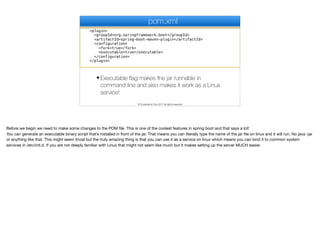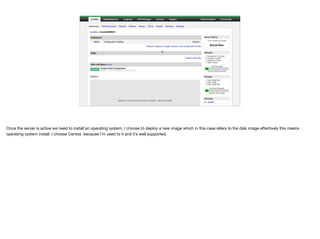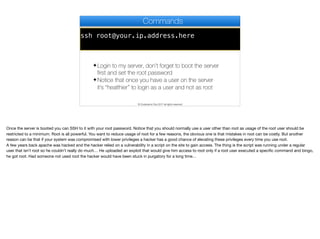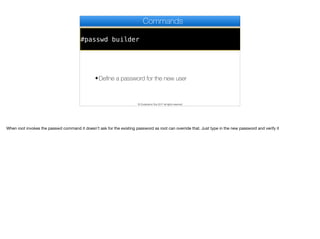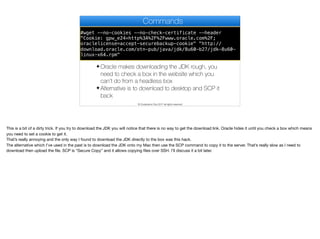Setting Up a Cloud Server - Part 1 - Transcript.pdf
- 1. Setting up a Cloud Server - Part I Setting up a server in the cloud is probably one of more tedious tasks we need to do. Even if you are a corporate developer who never has to do this I think there is a lot of value in understanding what goes into this. This module is aimed at a quick and dirty deployment. The goal of this tutorial isn’t to teach you scaling or complex ideas. Just to follow thru all the way.
- 2. <plugin> <groupId>org.springframework.boot</groupId> <artifactId>spring-boot-maven-plugin</artifactId> <configuration> <fork>true</fork> <executable>true</executable> </configuration> </plugin> pom.xml ✦ Executable flag makes the jar runnable in command line and also makes it work as a Linux service! © Codename One 2017 all rights reserved Before we begin we need to make some changes to the POM file. This is one of the coolest features in spring boot and that says a lot! You can generate an executable binary script that’s installed in front of the jar. That means you can literally type the name of the jar file on linux and it will run. No java -jar or anything like that. This might seem trivial but the truly amazing thing is that you can use it as a service on linux which means you can bind it to common system services in /etc/init.d. If you are not deeply familiar with Linux that might not seem like much but it makes setting up the server MUCH easier.
- 3. Server ✦I’ve setup a $5 1gb RAM Centos server on Linode which is a pretty decent supplier ✦I used MariaDB instead of MySQL since that’s the default for Centos ✦Linux servers are managed remotely via SSH, if you use Windows you can use an SSH/SCP client, since I use a Mac I just used the command line © Codename One 2017 all rights reserved I’m a big believer in sustainability. If running your startups backend is $5 per month that gives you a pretty decent chance of running without breaking the bank. A lot of startups including ourselves make the mistake of over scaling. We used App Engine which was very alluring at the time. The problem is that costs quickly ballooned to thousands of dollars per month which was totally unjustified, using a VPS is safe and scales with the need of your business. But lets go on and talk about the server itself. I used MariaDB instead of mysql in the production. On the desktop I preferred mysql since it had a better installer for Mac OS X. MariaDB is a fork of MySQL that is pretty much compatible. I normally prefer to have a similar environment on production and development but in this case I use a Mac instead of Linux anyway so I just went with it. I use SSH to login to the server. If you use Linux or Mac this is just a command line. For Windows users there are a lot of free SSH clients in the wild and you can use them.
- 4. We’ll start on the Linode site. I’m skipping some of the points related to signup billing etc. I just select the VPS type which in this case is the cheapest option and I create a new server instance.
- 5. Once the server is active we need to install an operating system. I choose to deploy a new image which in this case refers to the disk image effectively this means operating system install. I choose Centos because I’m used to it and it’s well supported.
- 6. I type in the root password which is something you need to remember so don’t lose that… Then deploy. Once I do that the server will take some time to setup. After it’s done press boot to start up the new VPS.
- 7. ssh [email protected] Commands ✦ Login to my server, don’t forget to boot the server first and set the root password ✦ Notice that once you have a user on the server it’s “healthier” to login as a user and not as root © Codename One 2017 all rights reserved Once the server is booted you can SSH to it with your root password. Notice that you should normally use a user other than root as usage of the root user should be restricted to a minimum. Root is all powerful. You want to reduce usage of root for a few reasons, the obvious one is that mistakes in root can be costly. But another reason can be that if your system was compromised with lower privileges a hacker has a good chance of elevating these privileges every time you use root. A few years back apache was hacked and the hacker relied on a vulnerability in a script on the site to gain access. The thing is the script was running under a regular user that isn’t root so he couldn’t really do much… He uploaded an exploit that would give him access to root only if a root user executed a specific command and bingo, he got root. Had someone not used root the hacker would have been stuck in purgatory for a long time…
- 8. #adduser builder Commands ✦We are adding a new user to the system so we won’t work as root for the actual process © Codename One 2017 all rights reserved So the first thing we do when we get to the server is create a new user called builder. We’ll use that user to run everything. You will notice the sharp character that is the command prompt of a root user on unix
- 9. #passwd builder Commands ✦Define a password for the new user © Codename One 2017 all rights reserved When root invokes the passwd command it doesn’t ask for the existing password as root can override that. Just type in the new password and verify it
- 10. #yum install wget Commands ✦ Yum automatically installs packages on Centos wget allows us to fetch some tools that we might need © Codename One 2017 all rights reserved In Linux we install packages and dependencies are resolved automatically. The underlying system in Centos is RPM which stands for Redhat Package Manager (Centos is a fork of RedHat). Yum takes that to the next level by connecting to servers and searching for the RPM packages and all the dependencies and then fetching everything you need to install. wget is a tool that can perform an http request to download a file from command line. Since we don’t have a display opening a browser isn’t really practical and this is reasonably convenient.
- 11. #wget --no-cookies --no-check-certificate --header "Cookie: gpw_e24=https%3A%2F%2Fblue-sea-697d.quartiers047.workers.dev%3A443%2Fhttp%2Fwww.oracle.com%2F; oraclelicense=accept-securebackup-cookie" "http:// download.oracle.com/otn-pub/java/jdk/8u60-b27/jdk-8u60- linux-x64.rpm" Commands ✦ Oracle makes downloading the JDK rough, you need to check a box in the website which you can’t do from a headless box ✦ Alternative is to download to desktop and SCP it back © Codename One 2017 all rights reserved This is a bit of a dirty trick. If you try to download the JDK you will notice that there is no way to get the download link. Oracle hides it until you check a box which means you need to set a cookie to get it. That’s really annoying and the only way I found to download the JDK directly to the box was this hack. The alternative which I’ve used in the past is to download the JDK onto my Mac then use the SCP command to copy it to the server. That’s really slow as I need to download then upload the file. SCP is “Secure Copy” and it allows copying files over SSH. I’ll discuss it a bit later.
- 12. #yum localinstall jdk-8u60-linux-x64.rpm Commands ✦ Just installs the jdk we downloaded from Oracle just now © Codename One 2017 all rights reserved You remember I said yum fetches things automatically. So you would expect to do something like yum jdk and have the JDK installed. Technically that would work and might even work here… All Linux distributions ship with OpenJDK which is the open source version of Java. It’s pretty similar but not identical to the Oracle JDK that we had to download. One of the main reasons I did this was support for JavaFX which doesn’t exist in the JDK. We need it for the CSS compiler and I wanted it to work. So I’m still using yum instead of rpm directly to install the package. Using yum is important as it can update its install database and resolve dependencies.

